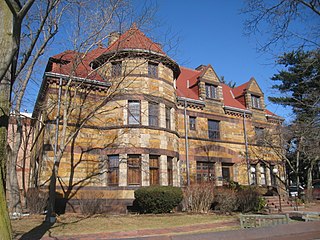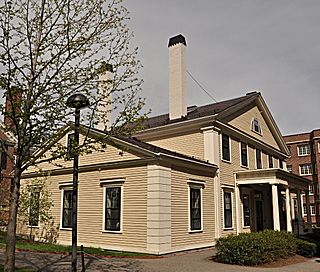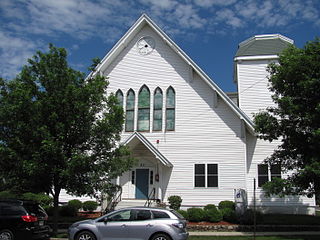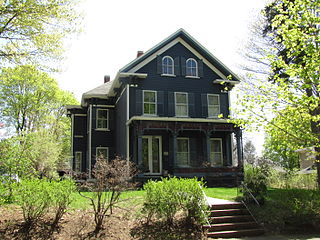
Harvard Yard is the oldest and among the most prominent parts of the campus of Harvard University in Cambridge, Massachusetts. The yard has a historic center and modern crossroads and contains most of the freshman dormitories, Harvard's most important libraries, Memorial Church, several classroom and departmental buildings, and the offices of senior university officials, including the President of Harvard University.

Harvard Square is a triangular plaza at the intersection of Massachusetts Avenue, Brattle Street and John F. Kennedy Street near the center of Cambridge, Massachusetts, United States. The term "Harvard Square" is also used to delineate the business district and Harvard University surrounding that intersection, which is the historic center of Cambridge. Adjacent to Harvard Yard, the historic heart of Harvard University, the Square functions as a commercial center for Harvard students, as well as residents of western Cambridge, the western and northern neighborhoods and the inner suburbs of Boston. The Square is served by Harvard station, a major MBTA Red Line subway station and a bus transportation hub.

Central Square is an area in Cambridge, Massachusetts centered on the junction of Massachusetts Avenue, Prospect Street and Western Avenue. Lafayette Square, formed by the junction of Massachusetts Avenue, Columbia Street, Sidney Street and Main Street, is also considered a part of the Central Square area. Harvard Square is to the northwest along Massachusetts Avenue, Inman Square is to the north along Prospect Street and Kendall Square is to the east along Main Street. The section of Central Square along Massachusetts Avenue between Clinton Street and Main Street is designated the Central Square Historic District, and was added to the National Register of Historic Places in 1990.

The Asa Gray House, recorded in an HABS survey as the Garden House, is a historic house at 88 Garden Street, Cambridge, Massachusetts. A National Historic Landmark, it is notable architecturally as the earliest known work of the designer and architect Ithiel Town, and historically as the residence of several Harvard College luminaries. Its most notable occupant was Asa Gray (1810–88), a leading botanist who published the first complete work on American flora, and was a vigorous defender of the Darwinian theory of evolution.

The William Dean Howells House is a house built and occupied by American author William Dean Howells and family. It is located at 37 Concord Avenue, Cambridge, Massachusetts. The house was designed by Howell's wife, Elinor Mead, and occupied by the family from 1873 to 1878. Authors including Mark Twain, Henry James, Henry Wadsworth Longfellow, and Thomas Bailey Aldrich visited the Howells in this house, as did President James Garfield, and Helen Keller lived there afterwards while attending school.

The William Morris Davis House is a National Historic Landmark on 17 Francis Avenue in Cambridge, Massachusetts. An architecturally undistinguished Queen Anne-era house, probably built in the 1890s, it is notable as the home of William Morris Davis between 1898 and 1916. Davis (1850-1934) was a professor of geology at Harvard University, and an influential figure in the development of meteorology and geomorphology as scientific disciplines. His textbook Elementary Meteorology was a standard of that field for many years. The house was declared a National Historic Landmark in 1976.

The 1767 Milestones are historic milestones located along the route of the Upper Boston Post Road between the cities of Boston and Springfield in Massachusetts. The 40 surviving milestones were added to the National Register of Historic Places in 1971. Massachusetts has a total of 129 surviving milestones including those along the upper Post Road. The stones are so named, despite having been placed in many different years, because of a 1767 directive of the Province of Massachusetts Bay that such stones be placed along major roadways. The state highway department was directed in 1960 to undertake their preservation. Many of them underwent a major restoration in 2018.

The Edwin Abbot House, also known as the Zabriskie House, is an historic house at 27 Garden Street in Cambridge, Massachusetts. Built in 1889 to a design by Longfellow, Alden & Harlow, it is a prominent local example of residential Richardsonian Romanesque architecture. It has served as the principal building of the Longy School since 1937. It was listed on the National Register of Historic Places in 1979, and included in the Follen Street Historic District in 1986.

The Ephraim Atwood House is an historic house at 110 Hancock Street in Cambridge, Massachusetts. Built in 1839, it is a significant local example of transitional Greek Revival/Gothic Revival architecture, and one of the earliest houses built after the subdivision of Dana Hill. It was listed on the National Register of Historic Places on June 30, 1983.

The Beck-Warren House, also known as the Warren House, is a historic house located in Cambridge, Massachusetts. Now on the campus of Harvard University, this large Greek Revival wood-frame house was built in 1833 for Professor Charles Beck, and was later purchased and adapted by the physically disabled Henry Clarke Warren, a Sanskrit scholar. Since 1899 it has belonged to Harvard University, for whom it presently houses offices. The house was listed on the National Register of Historic Places in 1996.

The Building at 104–106 Hancock Street is an historic cottage in Cambridge, Massachusetts. Built in 1839, it is a significant local example of transitional Greek Revival/Gothic Revival architecture, and one of the earliest houses built after the subdivision of Dana Hill. It was listed on the National Register of Historic Places in 1983.

The E. E. Cummings House is an historic house at 104 Irving Street in Cambridge, Massachusetts. The house was the childhood home of author and poet E. E. Cummings. The Colonial Revival house was built in 1893 for Cummings' parents, and was listed on the National Register of Historic Places in 1983.

The Maple Avenue Historic District is a residential historic district on Maple Avenue between Marie Avenue and Broadway in Cambridge, Massachusetts, United States. It encompasses a street with a cohesive collection of well-preserved, predominantly Italianate and Second Empire, houses, in which the original spacing and setting has been preserved. It includes houses on both sides of Maple Avenue, numbered from 8 to 33, among which stand several Queen Anne and Colonial Revival houses. The district was added to the National Register of Historic Places in 1983.

The Cooper–Davenport Tavern Wing is a historic building in Somerville, Massachusetts. Built c. 1806 by John Davenport as a wing to a 1757 tavern built by Jonathan Cooper, this is one of the few Federal-period buildings to survive in the city. Moved to its present location in the 1880s, it now houses residences. The building was listed on the National Register of Historic Places in 1989.

129 High Street in Reading, Massachusetts is a well-preserved, modestly scaled Queen Anne Victorian house. Built sometime in the 1890s, it typifies local Victorian architecture of the period, in a neighborhood that was once built out with many similar homes. It was listed on the National Register of Historic Places in 1984.

The First Unitarian Church is a historic former church building in Stoneham, Massachusetts. One of Stoneham's more stylish Gothic Revival buildings, the Stick style wood structure was built in 1869 for a Unitarian congregation that was organized in 1858. The building was listed on the National Register of Historic Places in 1984, and included in the Central Square Historic District in 1990. It presently houses the local Community Access Television organization.

15 Wave Avenue is a well-preserved Italianate style house in Wakefield, Massachusetts. It was built between 1875 and 1883, and was listed on the National Register of Historic Places on July 6, 1989.

Hartwell and Richardson was a Boston, Massachusetts architectural firm established in 1881, by Henry Walker Hartwell (1833–1919) and William Cummings Richardson (1854–1935). The firm contributed significantly to the current building stock and architecture of the greater Boston area. Many of its buildings are listed on the National Register of Historic Places.

Brattle Street in Cambridge, Massachusetts, called the "King's Highway" or "Tory Row" before the American Revolutionary War, is the site of many buildings of historical interest, including the modernist glass-and-concrete building that housed the Design Research store, and a Georgian mansion where George Washington and Henry Wadsworth Longfellow both lived, as well as John Vassall and his seven slaves including Darby Vassall. Samuel Atkins Eliot, writing in 1913 about the seven Colonial mansions of Brattle Street's "Tory Row," called the area "not only one of the most beautiful but also one of the most historic streets in America." "As a fashionable address it is doubtful if any other residential street in this country has enjoyed such long and uninterrupted prestige."

Dudley Community is an alternative to Harvard College's 12 Houses. The Dudley Community serves nonresident undergraduate students, visiting undergraduate students, and undergraduates living in the Dudley Co-op. In 2019, the Dudley Community was formed, reflecting the administrative split between the undergraduate and graduate programs that were under Dudley House since 1991. Affiliated undergraduates have access to Dudley Community advisers, programs, intramural athletics, and organized social events. Dudley Community administrative offices are currently housed in two suites in 10 DeWolfe St in Cambridge after moving from Lehman Hall. Lehman Hall now houses the student center for the Harvard Graduate School of Arts and Science.























